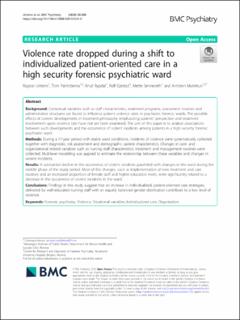| dc.description.abstract | Abstract BACKGROUND: Contextual variables such as staff characteristics, treatment programs, assessment routines and administrative structures are found to influence patient violence rates in psychiatric forensic wards. The possible effects of current developments in treatment philosophy emphasizing patients' perspective and treatment involvement upon violence rate have not yet been examined. The aim of this paper is to analyse associations between such developments and the occurrence of violent incidents among patients in a high security forensic psychiatric ward. METHODS: During a 17-year period with stable ward conditions, incidents of violence were systematically collected together with diagnostic, risk assessment and demographic patient characteristics. Changes in care- and organizational related variables such as nursing staff characteristics, treatment and management routines were collected. Multilevel modelling was applied to estimate the relationship between these variables and changes in violent incidents. RESULTS: A substantial decline in the occurrence of violent incidents paralleled with changes in the ward during the middle phase of the study period. Most of the changes, such as implementation of new treatment and care routines and an increased proportion of female staff and higher education levels, were significantly related to a decrease in the occurrence of violent incidents in the ward. CONCLUSIONS: Findings in this study suggest that an increase in individualized, patient-oriented care strategies, delivered by well-educated nursing staff with an equally balanced gender distribution contribute to a low level of violence. | |
